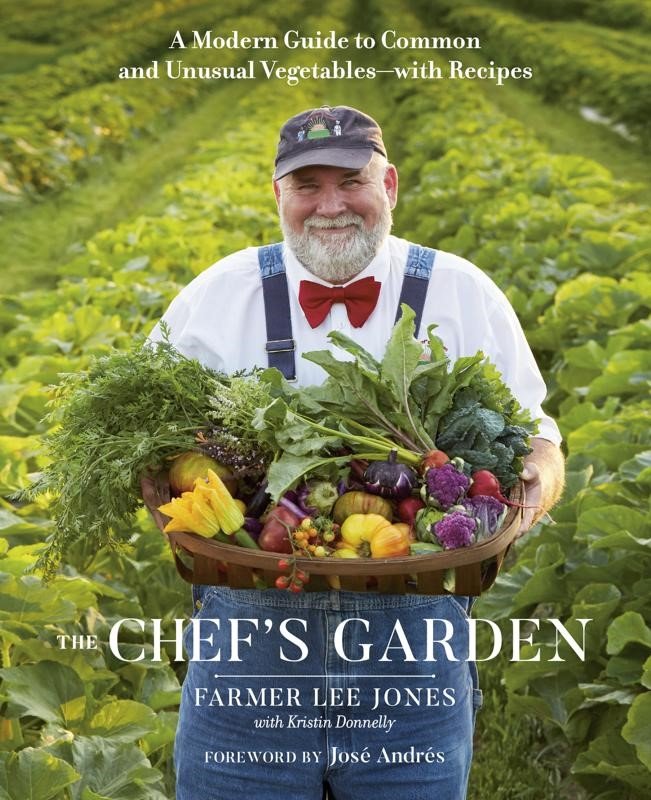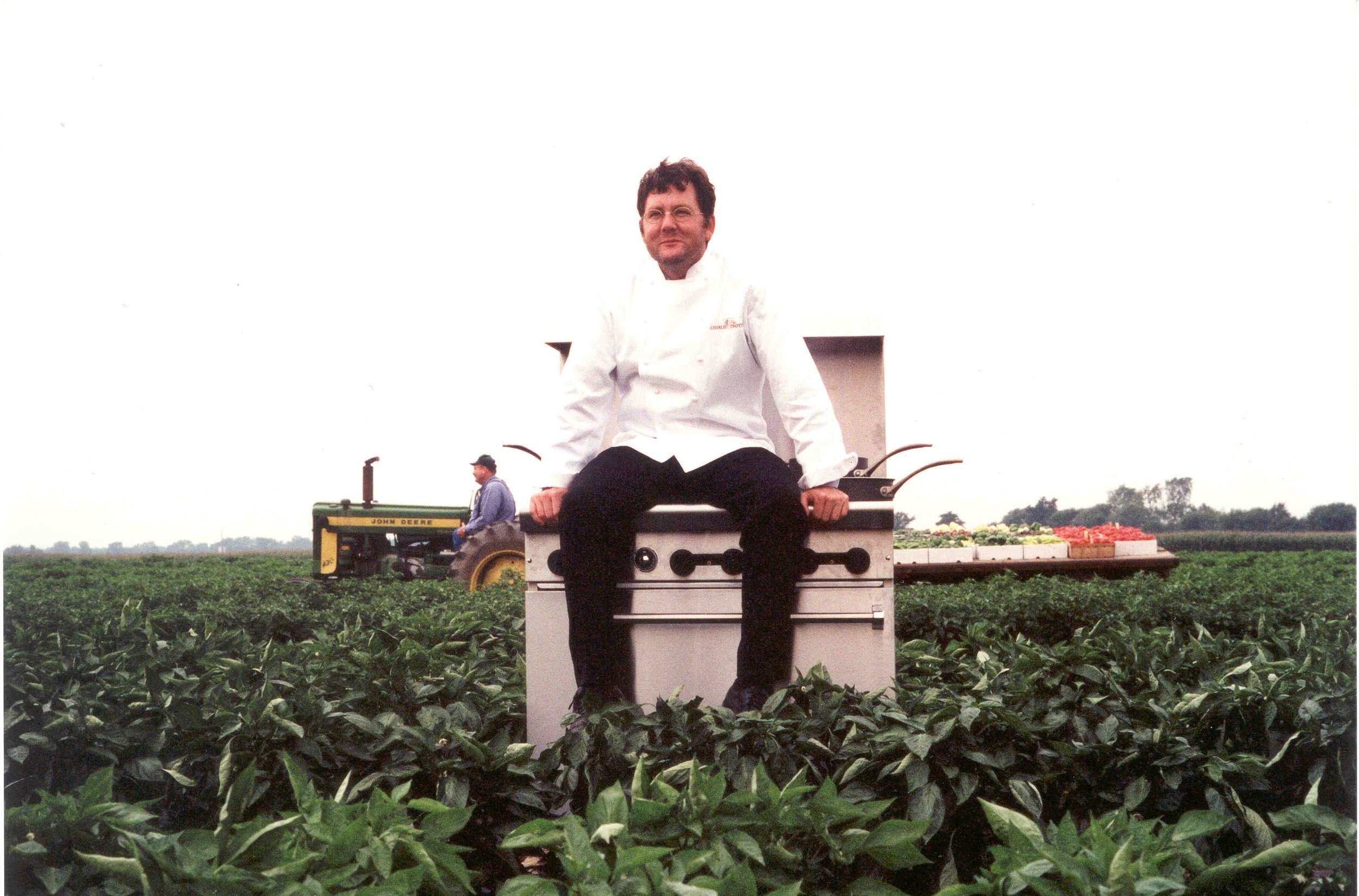The Chef's Garden; A Cookbook from Farmer Lee Jones
AUTHOR: ARTSY CHOW ROAMER ALL PHOTOS BY YOSSY AREFI & MICHELLE DEMUTH-BIBB
The Chef’s Garden
FARMER LEE JONES
Whose that man in the overalls with the pressed white dress shirt and the spiffy red bow tie? Farmer Lee Jones-that’s who! I’ll admit being the foodie that I am, I had never heard of him but on a recent long drive to visit my mother, I listened to a wonderful interview on our NPR station by local celebrity Lois Reitzes with the famed farmer.
Lois finds the most interesting people to talk with on her show and this day was no different. They were discussing Lee’s beautiful new cookbook called The Chef’s Garden which highlights his way of farming, the chef’s who mentored him and the recipes he loves that will make anyone in your life a vegetable eater.
You can tell why Jones is a good teacher. You can hear the excitement and joy he takes in farming and food in his voice. He speaks so reverently about the humble plant and the miracle that is getting your hands in the dirt to grow your own food. This post we’ll talk about why his father was ahead of his time and changed the way the family farm worked which turns out to be a pretty gosh darn good thing for us.
A BIT OF BACKGROUND
As is the way of most family farms in the US, you do what your Daddy did and his Daddy before him. The Joneses were no different. They worked hard bringing the food they grew to grocery stores to end up on the tables around America. Those grocery stores wanted things to look a certain way-pretty, waxed and consistent in size.
Think cucumbers for instance. They stack better if sized consistently and look nicer if waxed to a lovely dark green shine right? Grocery stores wanted you to think so anyway as they thought doing that would make you much more likely to buy.
So they wanted exactly the same number in a box and did pretty much the same thing with every other vegetable they could think of. Lee’s father along with he and his brother obliged them for years as they filled their boxes and shipped them off month after month to stores everywhere.
Farming is not easy and there were lots of lean years and hard economic times. But they still had their gatherings to celebrate life, love, families and growing stuff. To this day the outfit Farmer Lee is always seen in is an homage to those times; clean work overalls, a pressed white dress shirt and a red bow tie that say we may not be rich but we still clean up well!
Lee dedicates the cookbook “To Mom & Dad, for their dedication to God, their family and to helping folks all while striving to grow the best vegetables possible”. And so they did just like farmers everywhere. That is until they changed things up because Lee’s Dad, to his credit, was a curious man.
CHEFS AS MENTORS
He was a reader that liked to think on things and learn new ways to grow better veggies for the food tables he was serving. He got to thinking that maybe grocery stores weren’t the right ones to be driving the food truck so to speak. That it might be a good idea to start talking to the folks that cooked stuff for a living.
When Bob Jones Sr. slammed his fist down and announced back in the early 80’s that “his family was gonna start growing for chefs” in Huron, Ohio, that was a radical idea at the time but an extremely logical one if you really think on it some yourself. Chefs were starting to believe that going local was the way to get the freshest ingredients for their dishes and customers.
Bob Sr. was ahead of his time by making the bet that vegetables were the way of the future in the food world. Twenty years later, Chef Ferran Adria of El Bulli restaurant, would pronounce the very same thing while visiting Lee with Chef Charlie Trotter of Chicago fame.
While modest, Lee Jones is very aware that their idea of farming had a substantial influence on the culinary scene we enjoy today. Three generations of Chef’s have worked with and been influenced by the Jones bible of vegetable growing and no other farmers have had their hands on more veggies destined for the finest dining tables in America than them.
Farmer Lee and Chef Jamie Simpson talk food shop
In other words, they invested in farm to table dining and took a big risk doing so that has paid off for us foodies in the world today. Thank you very much! Chef’s wanted them to grow things that were never tried in the area before.
Chefs wanted things in any size which might provide special opportunities for different tastes, recipes and plate styling (ya know with those little tweezers 🤭) They rightly suggested that farming the way it was being done was not nutritious and food needed to be healthier and taste more flavorful. Europe has always done it that way. Some how we lost that map when we came here and started farming for the masses concentrating on how much food per acre we were raising.
The Joneses made you want to keep up with them…ya know what I mean? Because they started troweling and plowing the rows in a completely different way. I mean literally. Instead of planting row after row of the same kind of corn or lettuce, they started planting a few rows each of twenty different varieties of something creating beautiful fields of colorful foods like a painting on canvas.
They started looking at how you harvest certain vegetables-say squash for instance-that produced an edible blossom and promoted thinking about using the entirety of a plant through the full growing season from beginning to end.
ABOUT THE BOOK
As Spanish Chef Jose Andres wrote in his forward for the cookbook, this working relationship with the Jones family farm is what keeps the chefs in tune with the latest on all things vegetable. He says the experimental kitchen and the recipes Chef Simpson and others come up with help drive what to plant and grow.
In the words of the famous movie, “if you build it, they will come”, it has turned out to be more than true and he believes all the chefs that have visited the farm over the years have appreciated the ability to listen and learn from each other. He knows that Lee understands his soil around Lake Erie will produce the juiciest tomatoes, delicate squash blossoms and sweetest of corns and he farms for flavor as opposed to tonnage per acre. It might not grow as fast as sunny California but it definitely grows with better flavor instead.
The book is rich with interesting personal stories about Farmer Lee’s growing up years and his families refusal to give up on the idea of a family farm even while watching in horror as more and more of them shut their doors. It also details a sweet exchange between Lee and French-trained corporate Chef Iris Bailin who screamed in delight over squash blossoms and is generally credited with the Joneses vegetable journey.
She asked for arugula, radicchio, French breakfast radishes and more. She is the reason Bob Sr. went to California for seeds and met Alice Waters of Chez Pannis fame. For all of these reasons, the book is a celebration of what the Jones family does and the recipes not only sound delicious but exemplify the simple beauty of the vegetables they bring to chef’s fine dining establishments every day of every year.
TABLE OF CONTENTS
After a generous forward, preface and introduction, Farmer Lee gives you some good advise on equipment to have in your kitchen when working with vegetables. While most folks might have a high speed blender and juicer-a dehydrator and immersion circulator-not so much! Strainers, mandolins and slicers come in pretty handy and Jones suggests you donate all your Tupperware and start using reusable deli containers.
After giving you some nice to have ideas on appliances and tools he moves into food and recipes divided into six different sections: Alliums, Stems & Stalks, Leaves, Roots, Flower Buds Pods Seeds & Fruits and Edible Flowers. He finishes with some pantry ideas, acknowledgements and an index.
ALLIUMS
While most of the sections refer to parts of a plant, Lee decided to put Alliums, a specific type of plant, all together. Alliums are the plants most known for their funky/pleasant smell depending on your view. Those smells are produced by organosulfides and many chefs would be lost without the value added in their cooked or raw form.
By now you have probably guessed….that alliums would be your onions, leeks, shallots, cipollini, ramps, calcots, garlic….an onion by any name. Not only are they smelly and tasty but they have proven health benefits; the stinkier they are, the better the benefit.
I love a good pierogi and there is a dandy recipe that highlights this delicious Russian style dumpling with caramelized onions on top for texture and taste. Potatoes are a star as well and while this recipe may seem challenging it will be worth your effort when you finish it with a little sour cream and chive.
This same section will also bring you to the perfect method for roasting birds of any kind if you like your skin crispy that is. It is based on a similar method used in Peking Duck which I have been trying to achieve forever in my Czech duck cooking life to no avail!
For Broiled Cornish Hens with Onion Caramel you are supposed to boil water with a lot of salt in a pan large enough to hold the bird. Turn the heat off and dip or blanche the bird in that water for twenty seconds and allow it to dry out in the fridge overnight before continuing your recipe.
It gives you solid reasons behind doing this process which is guaranteed to give you a crisp finish on the now taut skin that hasn’t spread germs and pathogens all around your kitchen. That’s a win win in my book. The color on the bird by virtue of roasting with the onion caramel is to die for and would make any guest or family member happy when you present the finished product.
CHALLENGING RECIPES
Ramp Top Pasta has so many elements that come together in a splendor of green. I have a pasta maker so I like to sometimes forget the commercially available brands and just go for the fresher and lighter weight you get from making your own.
While this is always going to be more time consuming, Farmer Lee does give options for shortcuts should you desire to take them in his recipes. If you don’t have ramps you can also substitute scallions. Fiddlehead ferns might be a little more difficult to come by but your local farmers market usually has them.
Whole Foods and other specialty markets carry morels and this is an expensive but very tasty mushroom that is a favorite of mine. Peas and tendrils add flavor and texture and Jones even mentions he sometimes adds poached basil-fed snails to this recipe and gives you a place to buy them as well. (Who knew there was a snail lady in California who figured out feeding them basil was a good thing?)
LEAVES AND ROOTS
These sections bring a variety of recipes from drinks to apps and main dishes like Carrot Pot Roast. You can do the Garden Party Cocktail mentioned above with your own variety of herbs and edible flowers grown in your garden or purchased locally. Mezcal is one of the trendiest liquors to use in cocktails these days.
The pot roast is a riff on the real meat dish but feels hearty enough to not even need meat and can be enjoyed with good friends, crusty bread and a nice Cabernet. It incorporates the best of roasted veggies like potatoes, onions, carrots and more. You must make a demi-glace to achieve the desired colors and flavors but it will be well worth the effort when you set that pot on the table to cheers.
EDIBLE FLOWERS
Farmer Lee believes he has found a cure for seasonal affective disorder in the form of his flower house that grows over sixty-five different varieties. The smells, the dirt and the beauty of all the colors can’t help but draw your attention and make you understand the miracle of flowers. Even the light from the house on a dark cold night reminds them what is growing in the provided warm space that feels full of life.
I am reminded when looking at every photograph in this book that we eat with our eyes first. All foodies know this is the golden rule and plates should look as pretty as they eat. Adding an edible flower to your plate is just another aspect of love not to mention the health benefits of the antioxidants they provide as well.
This section will share all the flowers you can plant in your own garden and the kind of taste you can expect from each when cooking with them. It is very detailed and I had no idea so much color and taste could come from a small pretty flower.
Finally, you will get a nice list of the pantry items and condiments that the Culinary Vegetable Institute keeps on hand for R&D in the recipe department. You might want to fill out your own pantry with some of the choices as they are included in recipes in the book.
The institute is where all good chefs come to learn and experiment while appreciating the Joneses style of farming and supplying them with the best ingredients for their dishes. The Joneses in turn, learned lots of what they know about vegetables from this group.
They are the reason micro-greens appeared on menus. They are the reason pea tendrils can be golden instead of green. They are the reason radicchio came to Ohio and veggies were made small. In short, The Chef’s Garden is exactly that; born and built to please the creative chef who wanted only the best for his dishes and customers.
CONCLUSION
This is a radical cookbook in my opinion. The recipes are challenging but produce excellent quality with a chefs kitchen and table in mind. This is a book for both the lover of food and the lover of gardening. It will make you want to do something different this spring when planning your trip to buy seeds and plants.
It will make you want to clear some land, plow some rows, hoe some weeds and plant those seeds. If you have half the excitement Farmer Lee does for this process, you will have a magic garden indeed that will provide beautiful food for your table for years to come. Pick up a copy and start growing and enjoy the video below.
Farmer Lee talks about farming and growing food for chefs
If you enjoyed what you read, you might also like other posts under Edible Fare and Artful Ideal. Look for my next post on an interesting quilt exhibition you might want to check out. Until then…
Cheers,
Artsy Chow Roamer
Follow me on You Tube, Facebook, Pinterest, Instagram and Twitter
Food
If you like what you read, click on the button below!
Why? You’ll get a recipe for duck bacon which will impress anyone you serve it to plus other great stuff I promise you’ll want!













